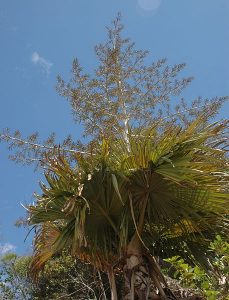Description: This rare palm can reach a height of over 18m in its natural habitat, and has large fan-shaped leaves. It has an unusual lifecycle, flowering only once before dying – essentially flowering itself to death! It reaches its massive height over the course of around 50 years, before the stem tip converts into a huge inflorescence which bursts into branches composed of hundreds of tiny nectar-rich flowers. These are pollinated by both insects and birds. The plant’s nutrient reserves are completely used up in the production of its fruits, and the entire tree then collapses and dies. There are only 100 or so individual examples of Tahina spectabilis in the wild.
Place of origin: Tahina spectabilis is endemic to northwest Madagascar, confined to a small area in Analalava district.
Did you know? This palm was unknown to science until 2008, when it was discovered by a French cashew plantation owner, whose photographs were passed on to researchers from the Royal Botanic Garden, Kew.

